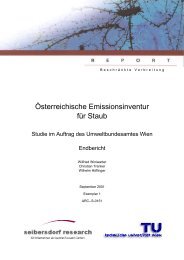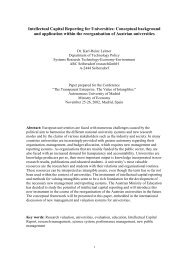ALPMON FINAL REPORT - ARC systems research
ALPMON FINAL REPORT - ARC systems research
ALPMON FINAL REPORT - ARC systems research
Create successful ePaper yourself
Turn your PDF publications into a flip-book with our unique Google optimized e-Paper software.
Contract ENV4-CT96-0359 <strong>ALPMON</strong><br />
4 Concept for the Establishment of a Remote Sensing Based Alpine<br />
Information System<br />
Based on the results derived within the <strong>ALPMON</strong> project and the outcome of their evaluation guidelines<br />
could be established for a remote sensing based Alpine Information System to be introduced to the<br />
Alpine Convention. The details for the single tasks are given in the respective work package reports.<br />
Here, only the main aspects for the establishment of the remote sensing data base shall be described.<br />
Satellite data: With respect to the area coverage and the related processing efforts as well as with<br />
respect to the data costs it is recommended to use Landsat 7 TM data for a data base covering the<br />
entire Alps (compare cost estimation, Table 16). For a coarse estimation of vegetation or forest cover<br />
also WIFS data proved to be useful. Only for more detailed investigations of special parameters over<br />
limited areas the use of higher resolution data (Spot 4, IKONOS) is recommended, as these increase<br />
the costs per km 2 significantly.<br />
Nomenclature: The nomenclature should be used as established within <strong>ALPMON</strong> (Annex 4), as this<br />
nomenclature is hierarchical and can easily be enhanced by additional classes or sub-classes with<br />
respect to different applications.<br />
Ground truth: In the course of the <strong>ALPMON</strong> project detailed ground truth was collected from five test<br />
sites distributed over the Alps and representing most of the different Alpine landscape characteristics.<br />
Further investigations now can be based on this harmonised ground truth data, which, of course has to<br />
be updated with respect to the acquisition of new satellite data. Nevertheless, further ground truth will<br />
have to be collected in areas, which are not yet sufficiently represented by the five test sites. It has to<br />
be taken into consideration that at least for every satellite flight path, which may include several<br />
satellite scenes, representative ground truth information must be available. Especially, in the Western<br />
part of the Alps this is not the case at the moment.<br />
For the ground truth survey, which should follow the common nomenclature, the following methods can<br />
be used:<br />
� interpretation of Colour Infrared aerial photos (1:5.000 - 1:20.000)<br />
� interpretation of Colour aerial photos (1:5.000 - 1:20.000)<br />
� interpretation of Black/White aerial photos (1:5.000 - 1:20.000)<br />
� field survey<br />
� processing of existing actual forest maps (1:5.000 - 1:10.000)<br />
� processing of existing topographic maps (1:10.000 - 1:50.000)<br />
� processing of existing actual orthophotos<br />
� processing of existing digital databases.<br />
It has to be kept in mind, that representative ground truth has to be available for independent training<br />
as well as verification reference data sets. This means, that enough samples of each parameter and<br />
category have to be collected for both tasks. According to Congalton (1991), a minimum of 50 samples<br />
for each vegetation or land use category is required only for the error matrix. If more than 12 categories<br />
are classified, the minimum number of samples should be increased to 75 or 100 samples per<br />
category. Practical considerations more often dictate the sample size selection, and a balance between<br />
what is statistically sound and what is practically attainable must be found. Guidelines are given to<br />
concentrate the sampling on categories of interest and increase their number of samples, whereas<br />
reducing the number of samples taken in less important categories. Fewer samples can be taken in<br />
categories showing little variability such as water and sampling should be increased in categories,<br />
which are more variable. With this, a stratified random sampling is recommended, as a minimum<br />
number of samples are selected from each strata (stratification geometrically or by land-use).<br />
Geocoding: The investigations have proved that the quality of the geocoding results is essential for<br />
the accuracy of results of image interpretation and classification, especially when using multi-temporal<br />
and multi-sensoral data sets and auxiliary information. Therefore, it is strongly recommended to apply<br />
a parametric, sensor-specific geocoding procedure, based on ground control points and a DEM. The<br />
co-registration of images form the same area can further improve the accuracy of data overlay. Best<br />
results within the <strong>ALPMON</strong> project could be obtained with the Remote Sensing Software Package<br />
Graz (RSG; by Joanneum Research) implemented in Erdas Imagine, the Satellite-Ortho Module from<br />
PCI, or the SILVICS software developed at the JRC in Ispra by N. McCormick (1997). Only if small<br />
scale maps (1:250.000 to 1:500.000) are envisaged, the acquisition of already geocoded Landsat 7 TM<br />
products is recommended.<br />
JR, RSDE, ALU, LMU, Seibersdorf, WSL 92




